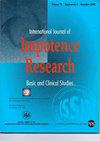HPV状态在阴茎鳞状细胞癌中的预后作用:一项系统回顾和荟萃分析。
IF 2.5
3区 医学
Q2 UROLOGY & NEPHROLOGY
引用次数: 0
摘要
阴茎鳞状细胞癌(PSCC)是一种罕见但侵袭性的恶性肿瘤,可以表现为人类乳头瘤病毒(HPV)相关或HPV独立。目前,关于HPV状态在PSCC中的预后价值或其在指导治疗策略中的作用尚未达成共识。因此,在本系统综述和荟萃分析中,我们旨在评估不同HPV状态测定方法对PSCC患者癌症特异性生存(CSS)和总生存(OS)的影响。在1980年至2025年2月间系统检索了MEDLINE、Embase和Cochrane Central Register of Controlled Trials等数据库。如果在PSCC患者中使用任何方法评估HPV状态,并报告CSS或OS,至少随访两年,则研究符合条件。排除病例报告、叙述性评论、专家意见和报告少于50名参与者的研究。使用QUIPS工具评估纳入研究的质量。2001年至2024年间发表的31项研究符合纳入标准,均为回顾性设计。高偏倚风险(RoB)被认为是研究损耗、预后因素测量和研究混杂。样本量从57到611人不等(中位数:152人)。19项研究通过DNA检测评估hpv状态,10项研究使用p16免疫组织化学(IHC)作为hpv驱动癌变的替代标志物。四项研究同时使用HPV DNA测量和p16免疫组化染色,两篇文章根据组织学分型确定HPV状态。中位随访时间为49.9个月(范围:27-107.9个月)。我们确定了23项研究,报告了足够的数据纳入荟萃分析,共包括5291名不同阶段PSCC的男性。其中,1946人(36.8%)患有hpv相关疾病。在1266例和1189例合并队列中,p16阳性状态分别与改善的CSS (HR = 0.40, 95% CI [0.20, 0.80], p = 0.009)和OS (HR = 0.49, 95% CI [0.29, 0.85], p = 0.01)相关。HPV DNA阳性与CSS改善相关(HR = 0.54, 95% CI [0.35, 0.83], p = 0.005),但与OS无关(HR = 0.86, 95% CI [0.70, 1.07], p = 0.17)。总之,p16和HPV DNA阳性与PSCC患者CSS改善相关。p16阳性状态与更好的OS相关,而基于DNA测量的HPV状态与更好的OS无关。这些发现强调了p16和HPV状态的预后价值。本文章由计算机程序翻译,如有差异,请以英文原文为准。

The prognostic role of HPV status in penile squamous cell carcinoma: a systematic review and meta-analysis
Penile squamous cell carcinoma (PSCC) is a rare but aggressive malignancy that can present as either Human papillomavirus (HPV)-associated or HPV-independent. Currently, there is no consensus on the prognostic value of HPV status in PSCC or its role in guiding treatment strategies. Therefore, in this systematic review and meta-analysis we aim to assess the impact of different methods of determining HPV status on cancer specific survival (CSS) and overall survival (OS) in patients with PSCC. Databases including MEDLINE, Embase, and Cochrane Central Register of Controlled Trials were systematically searched between 1980 and February 2025. Studies were eligible if they assessed HPV status using any method in PSCC patients and reported CSS or OS with a minimum follow-up of two years. Case reports, narrative reviews, expert opinions, and studies reporting less than 50 participants were excluded. Quality of included studies was assessed using the QUIPS tool. A total of 31 studies, published between 2001 and 2024, met the inclusion criteria, all of which were of retrospective design. High risk of bias (RoB) was noted for study attrition, prognostic factor measurement, and study confounding. Sample sizes ranged from 57 to 611 participants (median: 152 participants). HPV-status was assessed through DNA testing in 19 studies and 10 studies used p16 immunohistochemistry (IHC) as a surrogate marker of HPV-driven carcinogenesis. Four studies used both HPV DNA measurements and p16 IHC staining and two articles determined HPV status based on histological subtyping. Median follow-up was 49.9 months (range: 27-107.9 months). We identified 23 studies that reported sufficient data for inclusion in a meta-analysis, encompassing a total of 5291 men with various stages of PSCC. Of these, 1946 (36.8%) had HPV-associated disease. Positive p16 status was associated with improved CSS (HR = 0.40, 95% CI [0.20, 0.80], p = 0.009) and OS (HR = 0.49, 95% CI [0.29, 0.85], p = 0.01) in a pooled cohort of 1266 and 1189 patients respectively. HPV DNA positivity was associated with improved CSS (HR = 0.54, 95% CI [0.35, 0.83], p = 0.005), but not with OS (HR = 0.86 95% CI [0.70, 1.07], p = 0.17). In conclusion, p16 and HPV DNA positivity are associated with improved CSS in patients with PSCC. Positive p16 status was related to better OS, while HPV status based on DNA measurements was not. These findings underscore the prognostic value of p16 and HPV status.
求助全文
通过发布文献求助,成功后即可免费获取论文全文。
去求助
来源期刊

International Journal of Impotence Research
医学-泌尿学与肾脏学
CiteScore
4.90
自引率
19.20%
发文量
140
审稿时长
>12 weeks
期刊介绍:
International Journal of Impotence Research: The Journal of Sexual Medicine addresses sexual medicine for both genders as an interdisciplinary field. This includes basic science researchers, urologists, endocrinologists, cardiologists, family practitioners, gynecologists, internists, neurologists, psychiatrists, psychologists, radiologists and other health care clinicians.
 求助内容:
求助内容: 应助结果提醒方式:
应助结果提醒方式:


